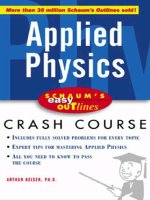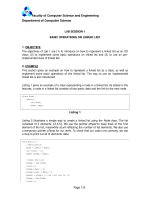faculty of engineering physics fep physics labwork
Bạn đang xem bản rút gọn của tài liệu. Xem và tải ngay bản đầy đủ của tài liệu tại đây (1.95 MB, 18 trang )
<span class="text_page_counter">Trang 1</span><div class="page_container" data-page="1">
Hanoi University of Science and Technology (HUST)
Faculty of Engineering Physics (FEP)
</div><span class="text_page_counter">Trang 2</span><div class="page_container" data-page="2">Experiment 1
MEASUREMENT OF BASIC LENGTH
Instruments 1. Vernier caliper; 2. Micrometer. 1. VERNIER CALIPER 1.1 Introduction
The Vernier Caliper is a precision instrument that can be used to measure internal and external distances extremely accurately. The details of a vernier principle are shown in Fig.1. An ordinary vernier caliper has jaws you can place around an object, and on the other side jaws made to fit inside an object. These secondary jaws are for measuring the inside diameter of an object. Also, a stiff bar extends from the caliper as you open it that can be used to measure depth. The accuracy which can be achieved is proportional to the graduation of the vernier scale.
Fig.1. Structure of an ordinary vernier caliper
When the jaws are closed, the vernier zero mark coincides with the zero mark on the scale of the rule. The vernier scale (T’) slides along the main rule (T). The main rule allows you to determine the integer part of measured value. The sliding rule is provided with a small scale which is divided into equal divisions. It allows you to determine the decimal part of measured result in combination with the caliper precision (∆), which is calculated as follows:
∆ (1) Where, is the number of divisions on vernier scale (except the 0-mark), then, for = 10 N Nwe have ∆ = 0.1 mm, = 20 we have N ∆ = 0.05 mm, and N = 50 we have ∆ = 0.02 mm.
1.2 How to use a vernier caliper
- Preparation to take the measurement, loosen the locking screw and move the slider to check if the vernier scale works properly. Before measuring, do make sure the caliper reads 0 when fully closed.
</div><span class="text_page_counter">Trang 3</span><div class="page_container" data-page="3">- Close the jaws lightly on the itewhich you want to measure. If you are measuring something round, be sure the axis of the part is perpendicular to the caliper. In other words, make sure you are measuring the full diameter. 1.3 How to read a vernier caliper In order to determine the measurement result with a vernier caliper, you can use the following equation:
D = n a + m ∆ (2) Where, is the value of a division on amain rule (in millimeter), i.e., = 1 amm, ∆ is the vernier precision and also corresponding to the value of a division on sliding rule that you can either find it on the caliper body or determine it’s value using the eq. (1).
- Step 1 Count the number of division :( ) on the main rule – , lying to the n Tleft of the 0-mark on the vernier scale – T’ (see example in Fig. 2)
- Step 2: Look along the division mark on vernier scale and the millimeter marks on the adjacent main rule, until you find the two that most nearly line up. Then, count the number of divisions ( ) on the vernier scale except the 0-mmark (see example in Fig. 2). - Step 3: Put the obtained values of n and m into eq. (2) to calculate the measured dimension as shown in Fig.2. Attention:
( ) a
( ) b
( ) c
Fig.2. Method to read vernier caliper
The Vernier scale can be divided into three parts called first end part, middle part, and last end part as illustrated in Fig. 2a, 2b, and 2c, respectively.
+ If the 0-mark on vernier scale is just adjacently behind the division on the main rule, the n division should be on the first end part of vernier scale (see example in Fig.2a). m+ If the 0-mark on vernier scale is in between the division andn n+1 on the main rule, the division should be on the middle part of vernier scale (see example in Fig.2b). m
+ If the 0-mark on vernier scale is just adjacently before the division n+1 on the main rule, the division should be on the last end part of vernier scale (see example in Fig.2c). mII MICROMETER
2.1 Introduction
The micrometer is a device incorporating a calibrated screw used widely for precise measurement of small distances in mechanical engineering and machining. The details of a micrometer principle are shown in Fig.3. Each revolution of the rachet moves the spindle face 0.5mm towards the anvil face. A longitudinal line on the frame (called referent one) divides the main rule into two parts: top and bottom half that is graduated with alternate 0.5
</div><span class="text_page_counter">Trang 4</span><div class="page_container" data-page="4">millimeter divisions. Therefore, the main rule is also called “double one”. The thimble has 50 graduations, each being 0.01 millimeter (one-hundredth of a millimeter). It means that the precision (∆) of micrometer has the value of 0.01. Thus, the reading is given by the number of millimeter divisions visible on the scale of the sleeve plus the particular division on the thimble which coincides with the axial line on the sleeve.
<small>Anvil face</small>
<small>Lock nutSleeve,</small>
<small>main scale - T Thimble – T’ScrewSpindle </small>
<small>face</small> <sup>Rachet</sup>
<small>Double rule</small>
<small>Referent lineThimble – T’Thimble edgeAnvil </small>
<small>Lock nutSleeve,</small>
<small>main scale - T Thimble – T’ScrewSpindle </small>
<small>face</small> <sup>Rachet</sup>
<small>Double rule</small>
<small>Referent lineThimble – T’Thimble edge</small>
Fig.3. Structure of an ordinary micrometer 2.2 How to use a micrometer
- Start by verifying zero with the jaws closed. Turn the ratcheting knob on the end till it clicks. If it isn't zero, adjust it.
- Carefully open jaws using the thumb screw. Place the measured object between the anvil and spindle face, then turn ratchet knob clockwise to the close the around the specimen till it clicks. This means that the ratchet cannot be tightened any more and the measurement result can be read.
2.3 How to read a micrometer
In order to determine the measurement result with a micrometer, you can also use the following equation:
D = n a + m ∆ (3) Where, is the value of a division on sleeve -adouble rule (in millimeter), i.e., = 0.5 mm, a ∆ is the micrometer’s precision and also corresponding to the value of a division on thimble (usually ∆ = 0.01 mm).
- Step 1 Count the number of division ( ) on the : nsleeve - of both the top and down divisions of the Tdouble rule lying to the left of the thimble edge. - Step 2: Look at the thimble divisions mark – T’ to find the one that coincides nearly a line with the referent one. Then, count the number of divisions ( ) on the thimble except the 0-mark m
- Step 3: Put the obtained values of and into n meq. (3) to calculate the measured dimension as the examples shown in Fig.4.
Please read carefully the following note when performing the measurement.
( ) a
( ) b
Fig. 4. Method to read micrometer
</div><span class="text_page_counter">Trang 5</span><div class="page_container" data-page="5">.Attention:
The ratchet is only considered to spin completely a revolution around the sleeve when the 0-mark on the thimble passes the referent line. As an example shown in Fig.5, it seems that you can read the value of as 6, nhowever, due to the 0-mark on the thimble lies above the referent line, then this parameter is
determined as 5. <sub>Fig.5. Ratchet does not spin completely a </sub>revolution around the sleeve, yet. III. EXPERIMENTAL PROCEDURE
1. Use the Vernier caliper to measure t external and internal diameter ( and D drespectively), and the height ( ), of a hmetal hollow cylinder (Fig.6) based on the method of using and reading this rule presented in part 1.2 and 1.3. Note: do 5 trials for each parameter. 2. Use the micrometer to measure the diameter (D<sub>b</sub>) of a small steel ball for 5 trials based on the method of using and reading this device presented in part 2.2
IV. LAB REPORT
Your lab report should include the following issues:
1. A data sheet with one data table of the measurement results for the height (h), external (D) and internal ( ) diameter of metal hollow cylinder, and one data table of the measurement dresults for the diameter (D<sub>b</sub>) of small steel ball.
2. Calculate the volume and density of the metal hollow cylinder using the following equations:
ρ <sub> (6) </sub>3. Determine uncertainties and report the last result of those quantities in the form like
4. Calculate the volume of the steel ball using the following equation:
V <sup>=</sup> <sup>π</sup> (7). 5. Determine uncertainty and report the last result of this quantity.
6. Note: Please read the instruction of “Significant Figures” on page 6 of the document “Theory of Uncertainty” to know the way for reporting the last result.
<small>4</small>
</div><span class="text_page_counter">Trang 6</span><div class="page_container" data-page="6">Experiment 2
MOMENTUM AND KINETIC ENERGY IN ELASTIC AND INELASTIC COLLISION Equipment:
1. Aluminum demonstration track; 2. Starter system for demonstration track; 3. End holder for demonstration track 4. Light barrier (photo-gate)
5. Cart having low friction sapphire bearings; 6. Digital timers with 4 channels;
7. Trigger.
I. THEORETICAL BACKGROUND
1. Momentum and conservation of momentum
Momentum is a physics quantity defined as product of the particle's mass and velocity. It is a vector quantity with the same direction as the particle's velocity.
r =p mv<sup>r</sup><sub> (1) </sub>Then we may demonstrate the Newton's second law as
dtpFr = <sup>r</sup>
Σ <sub> (2) </sub>The concept of momentum is particularly important in situations in which we have two or more interacting bodies. For any system, the forces that the particles of the system exert on each other are called internal forces. Forces exerted on any part of the system by some object outside it are called external forces. For the system, the internal forces are cancelled due to the Newton’s third law. Then, if the vector sum of the external forces is zero, the time rate of change of the total momentum is zero. Hence, the total momentum of the system is constant:
pF= = ⇒ =
Σ<sup>r</sup> 0 <sup>r</sup> <sup>r</sup> (3) This result is called the principle of conservation of momentum.
2. Elastic and inelastic collision 2.1 Elastic collision
If the forces between the bodies are much larger than any external forces, as is the case in most collisions, we can neglect the external forces entirely and treat the bodies as an isolated system. The momentum of an individual object may change, but the total for the system does
</div><span class="text_page_counter">Trang 7</span><div class="page_container" data-page="7">not. Then momentum is conserved and the total momentum of the system has the same value before and after the collision. If the forces between the bodies are also conservative, so that no mechanical energy is lost or gained in the collision, the total kinetic energy of the system is the same after the collision as before. Such a collision is called an elastic collision. This case can be illustrated by an example in which two bodies undergoing a collision on a frictionless surface as shown in Fig.1.
Fig. 1. Before collision (a), elastic collision (b) and after collision (c)
Remember this rule:
- In any collision in which external forces can be neglected, momentum is conserved and the total momentum before equals the total momentum after that is
<small>1</small>v' mv' mv mv
m<sup>r</sup> <sup>+</sup> <sup>r</sup> <sup>=</sup> <sup>r</sup> <sup>+</sup> <sup>r</sup> (4) - In elastic collisions only, the total kinetic energy before equals the total kinetic energy after that is
1 <sub>m</sub><sub>v</sub> <sub>+</sub><sub>m</sub><sub>v</sub> <sub>=</sub><sub>m</sub><sub>v</sub> <sub>+</sub><sub>m</sub><sub>v</sub>
(5) If the second body is in stationary (v<sub>2</sub> = 0) then taking the vector eq. (4) along the direction from left to right, results in
-m<sub>1</sub>v’<sub>1</sub> + m<sub>2</sub>v’<sub>2</sub> = m<sub>1</sub>v<sub>1</sub> (6) 2.2 Inelastic collision
A collision in which the total kinetic energy after the collision is less than before the collision is called an inelastic collision. An inelastic collision in which the colliding bodies stick together and move as one body after the collision is often called a completely inelastic collision. The phenomenon is represented in Fig.2.
m<sup>r</sup> <sup>+</sup> <sup>r</sup> <sup>=</sup> <sup>+</sup> <sup>r</sup> (7) In the case that the second mass is initially at rest (v<small>2 </small>= 0) then taking the vector eq. (9) along the direction from left to right, results in
m<sub>1</sub>v = (m<sub>1</sub> + m<sub>2</sub>)v’ (8) Let's verify that the total kinetic energy after this completely inelastic collision is less than before the collision. The motion is purely along the x-axis, so the kinetic energies K<sub>E</sub> and K’<sub>E</sub>before and after the collision, respectively, are:
K = <sub> (9) </sub>
Then, the ratio of final to initial kinetic energy is
</div><span class="text_page_counter">Trang 8</span><div class="page_container" data-page="8">- Step 1: Place the cart 1 (m<sub>1</sub>) on the left of track closer to the starter system. The cart m<sub>2</sub> is stationary between the photogates. It means that its initial velocity v<sub>2</sub> = 0. In this investigation, cart 2 is attached with a bow-shaped fork with rubber band facing cart 1 and a needle plug facing the end holder on the right of track (Fig. 4a). The photogate 1 should be located at position of 50 cm and photogate 2 at 100 cm. It is also noted that in this case, the weight m<sub>1</sub> should be haft of m<sub>2</sub> due to cart 2 is attached with an additional weight (400 g). - Step 2: Push the trigger on the top of vertically long stem of the starter system that enables cart 1 to be released and accelerate in the direction to cart 2 (initially in stationary that is v<sub>2</sub> = 0). During this process, it receives an initial velocity v<sub>1</sub> that can be calculated by the duration t<sub>1 </sub>when it goes through the photogate 1 corresponding to the shutter plate’s length. .
Fig. 3. Carts enclosed with shutter plates (a) and the timer for investigating the collision (b)
- Step 3: After collision, cart 2 moves with the velocity v’<sub>2</sub> that can be calculated by the using the duration t’<sub>2 </sub>measured by photogate 2 and cart 1 goes back (Fig. 4c). Record the time t<sub>1</sub>, t’<sub>1</sub>and t’<sub>2 </sub>displayed on the corresponding windows of timer as shown in Fig. 3b.
- Step 4: Repeat the measurement procedure from step 1 to 3 for more 9 times and record all the measurement results in a data sheet 1.
- Step 5: Weight two carts to know their masses by using an electronic balance. Record the mass of each cart on data sheet.
</div><span class="text_page_counter">Trang 9</span><div class="page_container" data-page="9">(c)
Fig.4. Experimental procedure to investigate the elastic collision
2.3 Investigation of inelastic collision
- Step 1: Place the cart 1 (m<sub>1</sub>) on the left of track closer to the starter system. Put off the right plug of cart 1 and attach the other one with a needle facing to cart 2 (Fig. 5a). Place the cart 2 (m<sub>2</sub>) also stationary between the photogates as in Part 2.2. In this circumstance, the fork plug facing cart 1 is replaced by another one having plasticine. It is noted that in this case, the weight m<sub>1</sub> should be twice m<sub>2</sub>. In order to get this condition, take off the additional weight from cart 2 and put it on cart 1.
(c)
Fig.5. Experimental procedure to investigate the inelastic collision
- Step 2: Push the trigger of the starter system that enables cart 1 to be released and accelerate in the direction to cart 2 similar previous case. Record the moving time t<sub>1</sub> that can be considered as (Fig. 5b). t
</div><span class="text_page_counter">Trang 10</span><div class="page_container" data-page="10">- Step 3: After collision, cart 1 sticks with cart 2 then both carts move together with the same velocity v’ that can be calculated by the duration t’<sub>1 </sub>= t’<sub>2</sub> = t’measured by photogate 2. Record the displayed on the timer (Fig. 5c). t’
- Step 4: Repeat the measurement procedure from step 1 to 3 for more 9 times and record all the measurement results in a data sheet 2.
- Step 5: Weight two carts to know their masses by using an electronic balance. Record the mass of each cart.
III. LAB REPORT
Your lab report should include the following content:
1. A data sheet with the recorded values of times before and after the collision (should be 10 trials) as well as masses of two carts for both cases of elastic and inelastic collision (with two separate data tables).
2. Check the conversation of momentum and kinetic energy before and after the collision in the elastic collision. In this case, based on the given and measured data we have
Where <sub>l</sub> is the length of the shutter plate.
Do calculation of the uncertainties in the momentum and kinetic energy before and after collision for each case. Make the conclusions of the obtained results.
3. Calculate the momentums and kinetic energies before and after the collision in the inelastic collision. In this case, based on the given and measured data we have
p <sup>=</sup><sub>1</sub><sup>l</sup><sup>and</sup> <sup>=</sup> <sub>1</sub> <sup>+</sup><sub>2</sub> <sup>l</sup>
Where is the length of the shutter plate. l
Do calculation of the uncertainties for the momentum and kinetic energy before and after collision for each case. Make the conclusions of the obtained results.
4. Evaluation of the percent changes in kinetic energy (K<sub>E</sub>) through the elastic and inelastic collision (using eq. 11). Make the conclusions of the obtained results.
Note: The collision is not completely elastic because there is still some residual friction when the carts move. That’s why the total momentum may decrease slightly by approximately 6 % and the kinetic energy may decrease up to 25 %.
5. Note: Please read the instruction of “Significant Figures” on page 6 of the document “ Theory of Uncertainty” to know the way for reporting the last result.
</div>








